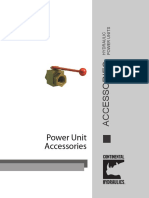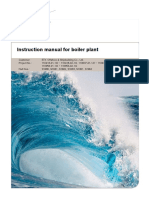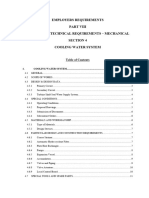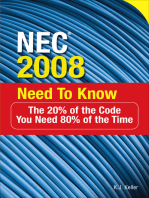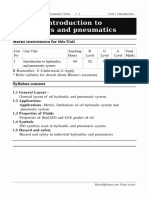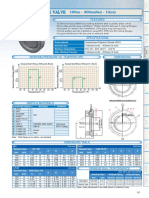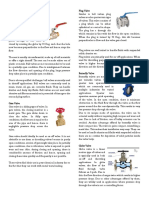Professional Documents
Culture Documents
A-Fo50 29-01 3001N Hydraulic Power, D&O
A-Fo50 29-01 3001N Hydraulic Power, D&O
Uploaded by
haugu2Original Title
Copyright
Available Formats
Share this document
Did you find this document useful?
Is this content inappropriate?
Report this DocumentCopyright:
Available Formats
A-Fo50 29-01 3001N Hydraulic Power, D&O
A-Fo50 29-01 3001N Hydraulic Power, D&O
Uploaded by
haugu2Copyright:
Available Formats
Fokker 50/60
60 29. Hydraulic Power
TECHNICAL TRAINING
Hydraulic Power
Description and Operation
Table of Contents
1. HYDRAULIC SYSTEM ................................................................................................
................................ ................................................. 2
1.1. Introduction ................................................................................................................................
................................ ................................... 2
1.2. System Set-up ................................................................................................
................................ .............................................................. 2
1.3. HYDRAULIC Panel ................................................................................................
................................ ....................................................... 5
1.4. Components ................................................................................................................................
................................ .................................. 6
• Engine Pumps ................................................................................................
................................ .......................................................... 6
• Pump Failure Indication ................................................................................................
.......................................... 8
• Pressure Transducer ................................................................................................
................................ ............................................... 9
• Fire Shut-off Valves ................................................................................................
................................ ............................................... 10
• Manifolds ..............................................................................................................................
................................ .............................. 11
• System Reservoir................................................................................................
................................ ................................................... 12
• Bleed-air Pressure
essure Regulating and Relief Valve ................................................................
.................................... 13
• Hydraulic Fluid Quantity and Overheat Indication ...............................................................
............................... 14
1.5. Hydraulic System Failure ................................................................................................
................................ ............................................ 15
1.6. Hydraulic System with System Accumulator ................................................................
.............................................. 16
1.7. Symbols ................................................................................................................................
................................ ...................................... 17
1.8. Location of Components ................................................................................................
................................ ............................................. 18
Fokker 50/60 29-01 Page 1
Code 3001N/Issue 1.6
Fokker 50/60
60 29. Hydraulic Power
TECHNICAL TRAINING
1. HYDRAULIC SYSTEM
1.1. Introduction
Hydraulic power comes from a hydraulic system, which has two engine pumps for normal
operation and an electric pump for maintenance. The hydraulic system supplies pressure at
3000 psi to operate:
- the flaps
- the landing gear operation
- the nose wheel steering
- the normal brakes
- the alternate brakes.
1.2. System Set-up
The hydraulic fluid is kept in the system reservoir, which is pressurized through air. The fluid
flows from this reservoir through left and right fire shut-off
off valves to the inlet ports of the engine
pumps. These pumps supply pressure at 3000 psi through pressure filter manifolds to the
consumers.
Each pressure filter manifold has:
- a pressure switch, which controls the ENG PUMP FAULT light on the control panel; this light
is on when the pressure is below 2500 psi
- check valves, which prevent reverse flows
flow
- a pressure relief valve, which opens and connects the pressure system to the return system
when the pressure is above 3500 psi
- a pressure filter
- a differential pressure indicator with switch.
The pressure filter manifold in the left accessory bay has one more check valve to let the
electric pump or a hydraulic rig pressurize the system.
Separate accumulators for the normal and alternate
alternate brakes make sure that a limited number of
brake applications is available when the hydraulic system fails.
The return fluid from the consumers flows back to the system reservoir through a return filter
manifold, which has:
- a filter
ssure indicator with a switch
- a differential pressure
- a through-pass
pass valve, which is used in case of a clogged return filter
- a check valve
- an anti-cavitation valve. The volume
v lume of the fluid drawn from the system reservoir differs from
the volume that goes back
ba when a piston with different surface areas is operated. The anti-
anti
cavitation valve is to compensate for the difference in fluid volumes.
The fluid, used for lubrication and cooling of the engine pumps, flows to the return system
through case drain lines. Check valves in these lines prevent the fluid from the system reservoir
to drain overboard when a case drain line is damaged.
Page 2 Fokker 50/60: 29-01
Code 3001N/Issue 1.6
Fokker 50/60
60 29. Hydraulic Power
TECHNICAL TRAINING
Engine-driven Pumps (EDP)
Reduction Gearbox
Engine Driven Pump
Fokker 50/60 29-01 Page 3
Code 3001N/Issue 1.6
Fokker 50/60
60 29. Hydraulic Power
TECHNICAL TRAINING
Hydraulic System
Page 4 Fokker 50/60: 29-01
Code 3001N/Issue 1.6
Fokker 50/60
60 29. Hydraulic Power
TECHNICAL TRAINING
1.3. HYDRAULIC Panel
The controls of the system are on the HYDRAULIC control panel. There are the following
controls:
- the L and R ENG PUMP pushswitches to switch the related engine pump off or on and to
show if the pump is in operation (no lights), defective (amber FAULT light on) or switched off
(white OFF light on)
- ELEC PUMP pushswitch switch to switch the electric pump on or off and to show when the switch
is in ON (white
white ON light on)
- the amber LO QTY (low quantity) light, which is on when the hydraulic fluid quantity in the
system reservoir is less than 38%
- the amber OVHT (overheat) light,light, which is on when the temperature of the hydraulic fluid in
the system reservoir is more than 90°C (194°F)
- the amber TANK PR (pressure) light, which is on when the air pressure in the system
reservoir is less than 15 psi
- the display, which shows the hydraulic
hydraulic fluid quantity (%) or the system pressure (PSI). The
display can also show the decay time (in seconds and tenth of seconds) during leak rate
tests.
The display on the control panel shows the system pressure when the rotary selector is in the
PRESS (PSI) position.
HYDRAULIC Panel
Fokker 50/60 29-01 Page 5
Code 3001N/Issue 1.6
Fokker 50/60
60 29. Hydraulic Power
TECHNICAL TRAINING
1.4. Components
• Engine Pumps
A pump is connected to each propeller gearbox. The pump is of the variable displacement type
and supplies a flow on demand at 3000 psi. The pump capacity is 34 liters/minute
lit (9 US
gallons/minute) at 4200 rpm.
The heart of the pump is a revolving cylinder barrel with nine pistons. A camplate moves these
pistons in and out when the cylinder barrel turns.
Normal operation
When the cylinder barrel starts to turn, the hydraulic fluid is
i moved from the inlet to the outlet
port and the outlet pressure increases quickly. The outlet pressure moves a pressure
compensator spool against the force of a spring (3000 psi) and pushes a stroking piston
against the force of a springloaded rate piston
piston through the open pressure compensator spool
and off-loader spool.
As a result, the camplate moves to a smaller angle and less fluid moves now to the outlet port.
When the outlet pressure is 3000 psi, the camplate is in the no-flow-position.
position.
When a consumer er is operated, the outlet pressure decreases lightly and the pressure
compensator spool moves to a more closed position. As a result the pressure on the stroking
piston decreases and the rate piston moves the camplate to a larger angle such that fluid
moves from the inlet to the outlet port; the pressure increases.
When the flow demand increases further, the stroking piston becomes connected to the return
system. The pump operates now at its maximum capacity (full flow).
When the flow demand decreases,
decrease the pressure increases. This causes the spring of the
pressure compensator spool to get compressed and the outlet pressure move the stroking
piston and therefore the camplate to a smaller angle. This goes on until the outlet pressure is
3000 psi.
Pump Operation #1
Page 6 Fokker 50/60: 29-01
Code 3001N/Issue 1.6
Fokker 50/60
60 29. Hydraulic Power
TECHNICAL TRAINING
Pump off-loading
When the L or R ENG PUMP pushswitch on the control panel is pushed to OFF, the related off-
loader solenoid energizes. The pump outlet pressure now controls the stroking piston through
the open off-loader
loader valve and off-loader
oader spool, while the pressure compensator spool is
isolated. This configuration makes sure that the pump outlet pressure becomes 500 psi, which
is necessary for pump cooling and lubrication.
If the pressure decreases below 500 psi, the off-loader spool moves to a more closed position
and the pressure for the stroking piston decreases. The rate piston now moves the camplate to
a larger angle to increase the pump outlet pressure to 500 psi.
Through the open off-loader
loader valve, the 500-psi pressure controls the outlet blocking valve which
closes the pump outlet port.
Pump Operation #2
Fokker 50/60 29-01 Page 7
Code 3001N/Issue 1.6
Fokker 50/60
60 29. Hydraulic Power
TECHNICAL TRAINING
• Pump Failure Indication
ndication
When the pump outlet pressure is below 2500 psi, contacts of the pressure switch on the
related pressure filter manifold close; this causes the amber ENG PUMP FAULT light on the
HYDRAULIC control panel to come on.
NOTE: This light cannot come on when:
- the aircraft is in take-off,
take or
- the related engine is off,
off or
- the related ENG PUMP pushswitch is in off,
off or
- the related fire handle is operated.
NOTE: When the two pump outlet pressures are below 2500 psi, an amber HYDR SYST light
on the central annunciator panel comes on, when this panel operates in the back-up
back
(BU) mode.
Pump Alerts
Page 8 Fokker 50/60: 29-01
Code 3001N/Issue 1.6
Fokker 50/60
60 29. Hydraulic Power
TECHNICAL TRAINING
• Pressure Transducer
Pressure information is supplied through a transducer which is near the left pressure filter
manifold. A pressure signal processor in the control panel changes the information such that it
can be shown on the display.
Left Accessory Bay
Front Spar Center Wing
Pressure Transmitter
Fokker 50/60 29-01 Page 9
Code 3001N/Issue 1.6
Fokker 50/60
60 29. Hydraulic Power
TECHNICAL TRAINING
• Fire Shut-off Valves
In case of an engine fire, a fire shut-off
shut valve closes and prevents hydraulic fluid to flow to the
engine pump. The valve has a DC motor which moves the valve to the shut position when the
related fire handle on the overhead panel is operated. A limit switch stops the DC motor when
the valve is in the shut position.
When the fire handle is moved back in the normal position, the DC motor opens the valve. One
more limit switch stops the DC motor when the valve is full open.
The fire shut-off
off valves are in the left and right accessory bays. Each valve shaft has an
indicator which shows the valve position.
Hydraulic Fire Shut-off
off Valve control
28V DC
EMER DC BUS 1 (2)
PULLED
2900-008
SHUT OPEN
M
== L (R) FIRE
SHUT-OFF
VALVE
Accessory Bay
Hydraulic Fire
Shut-off Valve
Page 10 Fokker 50/60: 29-01
Code 3001N/Issue 1.6
Fokker 50/60
60 29. Hydraulic Power
TECHNICAL TRAINING
• Manifolds
In each pressure supply line from the
the engine pump, there is a filter in the pressure filter
manifold.
NOTE: These filters have no bypass facility.
The head assembly of a pressure filter manifold has a latched-type latched type differential pressure
indicator which controls a magnetic indicator on the hydraulic ground-service
service panel in case of a
dirty filter. Each filter unit has one filter element.
The return filter manifold is very similar to the pressure filter manifold, but, it has a through-pass
valve built into the head assembly. This makes sure that that in case of a clogged return filter,
hydraulic fluid can flow back to the system reservoir, and the pressure in the return system
stays within limits.
The return filter manifold also has an anti-cavitation valve which prevents cavitation in case of
operation
ation of a consumer with different surface areas.
The pressure filter manifolds are in the left and right accessory bays. The return filter manifold
is in the hydraulic bay.
Accessory Bay
Differential Pressure
Switch and Indicator
Pump Low Pressure Switch
Outlet
Pressure Filter Manifold
Pressure Line Filter
Fokker 50/60 29-01 Page 11
Code 3001N/Issue 1.6
Fokker 50/60
60 29. Hydraulic Power
TECHNICAL TRAINING
• System Reservoir
The system reservoir is located in the hydraulic bay. It is made of stainless steel; the fluid
capacity is 10 liters (2.6 US gallons).
This reservoir has:
- a sight glass
- an alternate filler plug
- an air pressure connection
- a fluid quantity transmitter
- a temperature switch
- a manifold with supply connections
- a return connection
- a drain plug.
Hydraulic Reservoir
Page 12 Fokker 50/60: 29-01
Code 3001N/Issue 1.6
Fokker 50/60
60 29. Hydraulic Power
TECHNICAL TRAINING
• Bleed-airair Pressure Regulating and Relief Valve
V
Air supplied from the de-icing
icing panels through a double check valve is used to pressurize the
system reservoir. This prevents aeration and makes sure that there is a positive pressure at the
inlet ports of the engine pumps.
The pressure regulating and relief valve controls the reservoir air pressure at 40 psi while a
relief valve relieves the pressure when above 50 psi. One more relief valve va prevents the
reservoir air pressure to decrease below ambient through more than 1.5 psi.
When the reservoir air pressure is below 15 psi, the amber TANK PR light on the HYDRAULIC
control panel comes on.
In the AIR PRESS connection line near the hydraulic
hydraulic ground service panel is a small bleed
hole. This allows moisture to escape and prevents freezing of this line.
Alerts and Quantity Transmitter
Fokker 50/60 29-01 Page 13
Code 3001N/Issue 1.6
Fokker 50/60
60 29. Hydraulic Power
TECHNICAL TRAINING
• Hydraulic Fluid Quantity and Overheat Indication
In the system reservoir is a fluid quantity transmitter which is made up of a series of switches
and resistors. They are attached to a supporting board and protected through a guide tube.
This guide tube “guides” a float with a magnet.
Because the float and magnet move up and down with the level of the hydraulic fluid, only the
switch at that level is closed. The current agrees with the number of resistors in the circuit and
thus on the hydraulic fluid quantity in the system reservoir.
The current is suppliedlied to a quantity processor in the control panel which changes the
information such that it can be shown on the display when the display rotary selector is in
QTY (%).
When the fluid quantity is below 38%, the quantity processor supplies a ground signal to the
amber LO QTY light on the control panel.
When the temperature of the fluid is above 90°C (194°F), an overheat switch in the system
reservoir closes and supplies a ground signal to the amber OVHT (overheat) light on the
HYDRAULIC control panel. This switch is in a self-closing adapter to make its removal possible
without draining the system reservoir.
Quantity Indication
Page 14 Fokker 50/60: 29-01
Code 3001N/Issue 1.6
Fokker 50/60
60 29. Hydraulic Power
TECHNICAL TRAINING
1.5. Hydraulic System Failure
When the hydraulic system fails, the consumers operate as follows:
- normal brake control valves on accumulator pressure (1.64 cubic dm = 100 cubic inch)
- alternate brake control valves on accumulator pressure (0.8 cubic dm = 50 cubic inch)
- flaps through an electric motor
- landing gear extension through free-fall with springloaded downlocks
- nose-wheel steering
ring on the ground through differential braking or power.
power
All accumulators are of the cylinder-type
cylinder type with sealed end caps. One side of each accumulator
has nitrogen pressure; the other side the hydraulic pressure. The nitrogen and hydraulic fluid
are kept apart through a floating piston. The nitrogen pre-charge
pre charge pressure is 800 psi.
Movement of the pistons causes
cause a fluid layer on the wall of the cylinders. This hydraulic fluid in
the nitrogen side of the accumulators must regularly be removed through the drain
dra adapters on
the accumulators.
The accumulator of the normal brake control valves has a piston stop which prevents too much
hydraulic fluid to flow into this accumulator in case of a nitrogen pressure failure.
The normal brake accumulator is in the hydraulic
hydraulic bay; the alternate brake accumulator is in the
left main wheel bay.
Principle of Accumulators – Typical Example
3000 0 0
PSI PSI PSI
* * *
BRAKES BRAKES BRAKES
P<3000 PSI
P=3000 PSI P=800 PSI
>800 PSI
PISTON
STOP
(IN
IN NORMAL BRAKE
ACCUMULATOR ONLY)
ONLY
NITROGEN
2900-018
NITROGEN
CHARGE
Fokker 50/60 29-01 Page 15
Code 3001N/Issue 1.6
Fokker 50/60
60 29. Hydraulic Power
TECHNICAL TRAINING
1.6. Hydraulic System with System Accumulator
Some Fokker 50’s have a system accumulator to prevent pressure surges. This accumulator is
in the tail cone of the left nacelle. A pressure indicator and a charge valve are on the hydraulic
ground service-panel.
Three Accumulator Configuration
Page 16 Fokker 50/60: 29-01
Code 3001N/Issue 1.6
Fokker 50/60
60 29. Hydraulic Power
TECHNICAL TRAINING
1.7. Symbols
Fokker 50/60 29-01 Page 17
Code 3001N/Issue 1.6
Fokker 50/60
60 29. Hydraulic Power
TECHNICAL TRAINING
1.8. Location of Components
Component Location
Alternate brake accumulator In left main-wheel bay
Bleed-air pressure-regulating
regulating and relief-valve
relief In hydraulic bay
Bleed-air check valve In left main-wheel bay
Electric pump In hydraulic bay
Engine pumps One on each reduction gearbox
Fire shut-off valves One in each accessory bay
Normal brake accumulator In hydraulic bay
Hydraulic bay At the rear end of the left nacelle
Hydraulic ground-service
service panel In hydraulic bay
Pressure filter manifold One in each accessory bay
Return filter manifold In hydraulic bay
Seal drain and overflow tank Near hydraulic ground service panel
System reservoir In hydraulic bay
Low air-pressure switch In hydraulic bay
System pressure transducer In left accessory bay
Sample valve In left main-wheel bay
Page 18 Fokker 50/60: 29-01
Code 3001N/Issue 1.6
You might also like
- 11004010-Bobcat 863 Skid Steer Loader Service Repair Workshop Manual Download S N 514425001 Above S N 514525001 Above S N 514625001 AboveDocument534 pages11004010-Bobcat 863 Skid Steer Loader Service Repair Workshop Manual Download S N 514425001 Above S N 514525001 Above S N 514625001 Aboveandy miller83% (18)
- Technical Analysis from A to Z, 2nd EditionFrom EverandTechnical Analysis from A to Z, 2nd EditionRating: 4.5 out of 5 stars4.5/5 (19)
- THE LTSPICE XVII SIMULATOR: Commands and ApplicationsFrom EverandTHE LTSPICE XVII SIMULATOR: Commands and ApplicationsRating: 5 out of 5 stars5/5 (1)
- 2003 Ford 6.0 DITDocument106 pages2003 Ford 6.0 DITPhil B.95% (20)
- Koomey S&s ManualDocument0 pagesKoomey S&s Manualborregocr91% (11)
- CNC Machining Handbook: Building, Programming, and ImplementationFrom EverandCNC Machining Handbook: Building, Programming, and ImplementationNo ratings yet
- Manual Manifold AmicoDocument46 pagesManual Manifold AmicoFelipe Gagliardi de Paula100% (1)
- 6.0L Features Book 2003.25Document106 pages6.0L Features Book 2003.25Miguel Chacon100% (3)
- Toyota Hilux Kijyang Innova 1kd 2kd PDFDocument68 pagesToyota Hilux Kijyang Innova 1kd 2kd PDFpalaboy88892% (13)
- Hydraulic SystemDocument36 pagesHydraulic Systemoleg-spb67% (3)
- Common Rail Hino - ToyotaDocument41 pagesCommon Rail Hino - Toyota0808833892% (24)
- Denso Toyota Hilux Common RailDocument68 pagesDenso Toyota Hilux Common Railbugyman_02100% (4)
- Carrier Bus Air Conditioning Rearmount 68RM35-604-20 (R134a) Operation&Service Manual (NYCDOT) Pub#T288Document45 pagesCarrier Bus Air Conditioning Rearmount 68RM35-604-20 (R134a) Operation&Service Manual (NYCDOT) Pub#T288Clifton Jamison60% (5)
- Schaum's Outline of Basic Electricity, Second EditionFrom EverandSchaum's Outline of Basic Electricity, Second EditionRating: 5 out of 5 stars5/5 (14)
- A 319/320/321 Airbus: ATA 36 PneumaticDocument144 pagesA 319/320/321 Airbus: ATA 36 PneumaticBahadorNo ratings yet
- Ch5 - DA40 - Hydraulics 2 Pumps SolutionDocument58 pagesCh5 - DA40 - Hydraulics 2 Pumps SolutionaugustoNo ratings yet
- Acumulador 1Document30 pagesAcumulador 1Carolina GalavisNo ratings yet
- Pump Protection - Tech ArticleDocument20 pagesPump Protection - Tech ArticleMuhammad Imran100% (2)
- Re 01200Document24 pagesRe 01200Ahmed Abd ElhakeemNo ratings yet
- Power Unit AccessoriesDocument71 pagesPower Unit AccessoriesHoàng DanhNo ratings yet
- Char Lynn Hydaulic Steering Catologue 2003 Part1Document50 pagesChar Lynn Hydaulic Steering Catologue 2003 Part1Sunthron SomchaiNo ratings yet
- 08 Accumulator, TravelDocument151 pages08 Accumulator, TravelWu Sono100% (1)
- 750-183 OM Boiler Mate June10Document51 pages750-183 OM Boiler Mate June10Bülent KabadayiNo ratings yet
- Service Manual: Service Manual Section Heat Ventilation Air Conditioning (Hvac) SystemDocument191 pagesService Manual: Service Manual Section Heat Ventilation Air Conditioning (Hvac) SystemLuciano NavarreteNo ratings yet
- 60l Power StrokeDocument106 pages60l Power Strokethebigfishx100% (1)
- Ap100 - 200 P 991218 e 05Document28 pagesAp100 - 200 P 991218 e 05Jose SalvadorNo ratings yet
- Acquity UPLC H-Class Binary Solvent ManagerDocument122 pagesAcquity UPLC H-Class Binary Solvent ManagerFrancescoNo ratings yet
- Dash 8 400 Sys Desc Handout - HydDocument128 pagesDash 8 400 Sys Desc Handout - Hydsolomon.mehrettNo ratings yet
- M35-Composite Boiler, Aux. BoilerDocument1,832 pagesM35-Composite Boiler, Aux. BoilerAlex100% (1)
- Solar 130lc-V Hydraulic SystemDocument289 pagesSolar 130lc-V Hydraulic SystemHai Van83% (6)
- Sn-3hep-Section-04-Cooling Water SystemDocument16 pagesSn-3hep-Section-04-Cooling Water SystemAn KsNo ratings yet
- FuelDocument94 pagesFuelHend GhanemNo ratings yet
- 8009 PDFDocument42 pages8009 PDFlungu mihaiNo ratings yet
- InstallationDocument200 pagesInstallationhemenedy100% (1)
- Super Hydraulic System - GMK5100Document38 pagesSuper Hydraulic System - GMK5100Eli DanNo ratings yet
- Fuso 6m60Document20 pagesFuso 6m60Dowane Charles94% (33)
- Making Everyday Electronics Work: A Do-It-Yourself Guide: A Do-It-Yourself GuideFrom EverandMaking Everyday Electronics Work: A Do-It-Yourself Guide: A Do-It-Yourself GuideRating: 4 out of 5 stars4/5 (2)
- Nonlinear Traction Control Design for Parallel Hybrid VehiclesFrom EverandNonlinear Traction Control Design for Parallel Hybrid VehiclesNo ratings yet
- Powerboater's Guide to Electrical Systems, Second EditionFrom EverandPowerboater's Guide to Electrical Systems, Second EditionRating: 5 out of 5 stars5/5 (1)
- Striving for Clean Air: Air Pollution and Public Health in South AsiaFrom EverandStriving for Clean Air: Air Pollution and Public Health in South AsiaNo ratings yet
- Electronics from the Ground Up: Learn by Hacking, Designing, and InventingFrom EverandElectronics from the Ground Up: Learn by Hacking, Designing, and InventingRating: 3.5 out of 5 stars3.5/5 (2)
- Electronics Workshop Companion for HobbyistsFrom EverandElectronics Workshop Companion for HobbyistsRating: 3.5 out of 5 stars3.5/5 (3)
- IT38G Fuel SitemaDocument24 pagesIT38G Fuel Sitemavitor santosNo ratings yet
- Daf CompDocument2 pagesDaf CompNakclean Water SolutionsNo ratings yet
- Ships Spares CatalogueDocument35 pagesShips Spares CatalogueChittagong Port AgentNo ratings yet
- Hydro-Power Plants Generation Company ASWAN Hydraulic Training CenterDocument108 pagesHydro-Power Plants Generation Company ASWAN Hydraulic Training CenterMahmoud MohammedNo ratings yet
- KSB Pumps CatalogDocument208 pagesKSB Pumps CatalogMuhammad Faheem ShahbazNo ratings yet
- تست شیر نشت حباب Valve Leakage Rates Test StdDocument8 pagesتست شیر نشت حباب Valve Leakage Rates Test StdPA PlantNo ratings yet
- Piping Class Specification - CNE-001-2006-E-08-M-L-10126Document20 pagesPiping Class Specification - CNE-001-2006-E-08-M-L-10126Mubashir fareedNo ratings yet
- Data Sheet - DHDA Test PumpDocument2 pagesData Sheet - DHDA Test PumpDeepak DeepuNo ratings yet
- Design and Analysis of Annular Combustion Chamber For A Micro Turbojet EngineDocument6 pagesDesign and Analysis of Annular Combustion Chamber For A Micro Turbojet EngineChahbeddine ChbilNo ratings yet
- C-10 Crusher: Parts ManualDocument63 pagesC-10 Crusher: Parts ManualYokai-12No ratings yet
- To Hydraulics: PneumaticsDocument126 pagesTo Hydraulics: PneumaticsDipak100% (1)
- Asahi Wafer Check ValveDocument1 pageAsahi Wafer Check ValveDuy Nguyen DucNo ratings yet
- Types of ValvesDocument5 pagesTypes of Valvesjeamnard balitaan100% (1)
- API Standards: Pumps Api STD Edition Year PublishedDocument3 pagesAPI Standards: Pumps Api STD Edition Year PublishedSlbcar LoogingNo ratings yet
- uPVC Pressure Grey Pipes BS PDFDocument3 pagesuPVC Pressure Grey Pipes BS PDFChetan ToliaNo ratings yet
- R5 RA 0063/0100 F: Rotary VaneDocument3 pagesR5 RA 0063/0100 F: Rotary VaneNitin KurupNo ratings yet
- Valves and Dampers Gyanendra Sharma NPTI DelhiDocument54 pagesValves and Dampers Gyanendra Sharma NPTI DelhiNPTI100% (2)
- 11ADocument7 pages11APoonam AshwinNo ratings yet
- Teh 375a PDFDocument27 pagesTeh 375a PDFomarNo ratings yet
- Design - Horizontal Countercurrent Flow TEMA BEM Shell With Single-Segmental BafflesDocument1 pageDesign - Horizontal Countercurrent Flow TEMA BEM Shell With Single-Segmental BafflesherNo ratings yet
- LS-20S - SullairDocument102 pagesLS-20S - SullairWalter Carmona100% (1)
- Ajith Kumar Mechanical FitterDocument3 pagesAjith Kumar Mechanical FitterVijayan VijayNo ratings yet
- 4gala - 5451 - Bronze Swing Check ValveDocument1 page4gala - 5451 - Bronze Swing Check ValveAbadimetal UtamaNo ratings yet
- Analysis of Axial & Centrifugal Compressors: To Be Selected As Per Specific Speed of ApplicationsDocument31 pagesAnalysis of Axial & Centrifugal Compressors: To Be Selected As Per Specific Speed of ApplicationsNitish KumarNo ratings yet
- Sauer Danfoss PV PumpDocument11 pagesSauer Danfoss PV PumpCristian100% (2)
- Vind Flow Data CompressDocument5 pagesVind Flow Data CompressMohan BabuNo ratings yet
- Ul Aire GD MideaDocument15 pagesUl Aire GD Mideaeduin gonzalezNo ratings yet
- Overhauling of Centrifugal PumpDocument4 pagesOverhauling of Centrifugal Pumpanil thakur100% (1)
- Ventury & Orifice MeterDocument11 pagesVentury & Orifice MeterChirag SabhayaNo ratings yet




















